Active Galactic Nuclei

AGN galaxies are identified the presence of a compact, luminous, and often variable
nucleus. This extra nuclear activity is due to a powerful central engine that produces a wide variety of
exotic features, such as relativistic jets, radio lobes, high-energy emission, broad UV and optical emission
lines, and maser emission. In optical images Sefert galaxies and quasars appear to have a bright, stellar,
unresolved nucleus surrounded by a normal looking "host" galaxy.
AGN's: A Taxonomic Primer
Spectroscopically, AGN's fall into 5 basic categories:
Seyfert 1, Seyfert 2, quasars, blazars, and related objects such as LINER's
and starburst nuclei. Other forms include radio galaxies and ultra-luminous
infrared galaxies.
Seyfert 1 galaxies are characterized by the presence of both narrow and broad
emission lines, superposed onto a relatively featureless blue continuum.
The emission lines are formed when atoms in the gas clouds are photo-ionized by the
continuum radiation from the central source.
The broad lines are formed by high density gas clouds located
close in to the central engine. We know these clouds are of high-density because we only see broad
emission from permitted line transitions (hydrogen Lyman and Balmer series, Mg II, He II, Fe II, C IV et al).
The huge line widths from the doppler broadening
(1000's km/sec) imply that the line forming regions are moving at high velocities around a compact,
massive object.
The narrow lines are formed by low-density gas clouds outside of the nuclear region. Both permitted and
forbidden line transitions are present. The forbidden transitions occur because the gas density is low enough
that collisional de-excitation does not occur. (Forbidden lines include [O II], [O III], [Ne III], [N I],
[N II], [Fe VII], and [S II].) These lines are typically doppler broadened to ~100's km/sec widths,
so they are broader that typical line widths of LINER and starburst galaxies.
The continuum often has absorption features from the "host" galaxy, or of intervening material such
as the Lyman-alpha forest of hydrogen clouds and galactic halos.
Optical spectra of Seyfert 1 galaxies are very distinct:
NGC5548 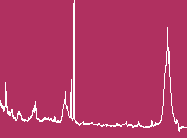 NGC4151
Mrk335
Akn120
Mrk509
Mrk279
NGC4151
Mrk335
Akn120
Mrk509
Mrk279 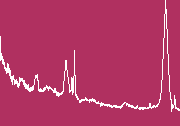 NGC7469
NGC7469
Seyfert 2 galaxies are characterized by having only narrow emission lines, once again formed
from low density gas clouds outside of the nuclear region. These lines are typically doppler
broadened to ~100's km/sec widths. It is likely that Seyfert 1 galaxies
and Seyfert 2 galaxies are are the both the same type of object, but viewed from different
orientations.
Optical spectra of Seyfert 2:
NGC1068 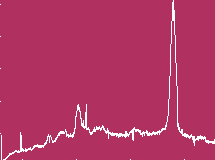 NGC5252
NGC5252 
Quasars (quasi-stellar-radio-source) have an ultra-high nuclear luminosity. They can be seen over
great distances. Quasar spectra typically reveal broad emission and absorption features.
LINER (low-ionization nuclear emission region) galaxies have lower nuclear luminosity than the
Seyferts. They do not have a "stellar" nucleus. LINERs have strong emission lines from some
of the low-ionization state species,
including [O I], [O II], [S II], and [N II].
Blazar spectra reveal a mostly featureless continuum without strong emission lines. Blazars
do have both absorption and emission features in their spectra, but those features are generally weak,
narrow, and
variable on short time scales (days). The featureless spectra is due to orientation; we are looking
straight down into a relativistic jet that is beamed at us. The blazar Mrk421 is also a high-
energy gamma-ray source. A recent hypothesis explaining the source of these gamma rays suggests that
mass-losing stars are in the path of the relativistic jet. Electrons interacting with the star's
shock wave and the jet are accelerated to high velocities, emitting gamma-rays in the process.
AGN's: Physical Structure
The central engines of AGN's consist of a super-massive black-hole
with an accretion disk. 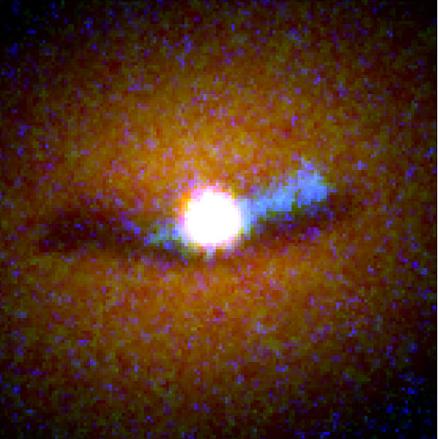
The accretion disk is surrounded by high- and low- density clouds of gas and other star-debris.
The whole disk assembly is engulfed by a dusty torus.
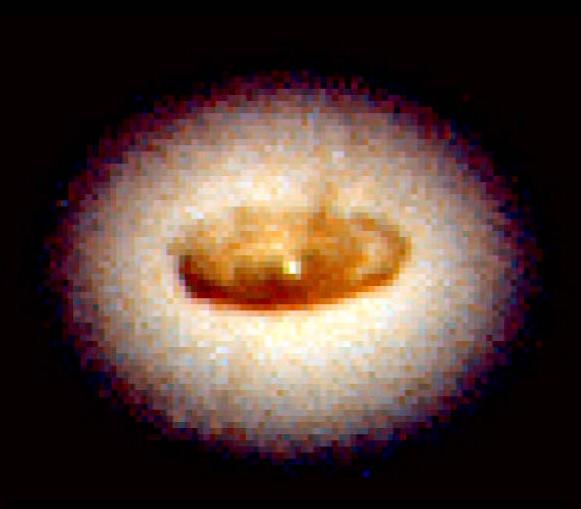
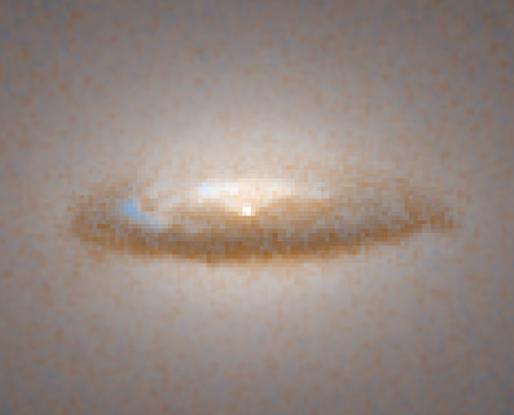
The central engines, even for the quasars, appear to reside in normal
looking host galaxies, 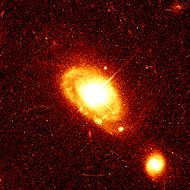
although they are often seen to be interacting with neighboring galaxies.
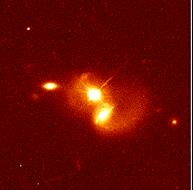
The standard AGN model can be used to unify the spectral classes of AGNs. AGN spectra can be explained
by viewing the standard model from different orientations.
AGN's: Evolution
AGN evolution is very likely closely related to galaxy mergers. Many AGN's have been found
to contain double or multiple nuclei. A word of caution though, we also see many non-AGN
galaxies that contain multiple nuclei.
AGN's: Object Lists
Seyfert 1 galaxies include: NGC4151, NGC4558, NGC4261, NGC6251, NGC4051, NGC3516, NGC3783, NGC6814
NGC7469, Mrk335, Mrk478, Mrk590
Seyfert 2 galaxies include: Mrk1073, NGC5252, NGC1068, NGC1068, NGC1667, NGC5506
LINER galaxies include: NGC1052
Blazar galaxies include: BLLac, Mrk421, 3C345
Broad line radio galaxies include: 3C390.3, 3C120, 3C10, Arp102B, 3C445,
3C382, 3C234, PictorA
Radio galaxies include: NGC1275, 3C175, M84 (NGC4373)
Quasars include: 3C273, 3C48
Ultra-Luminous Infrared Galaxies (ULIGs) include: Mrk463, Arp299, Mrk231,
Arp220, NGC6240, Mrk1014, Mrk273
Normal Galaxies:


 NGC4151
Mrk335
Akn120
Mrk509
Mrk279
NGC4151
Mrk335
Akn120
Mrk509
Mrk279  NGC7469
NGC7469
 NGC5252
NGC5252 




